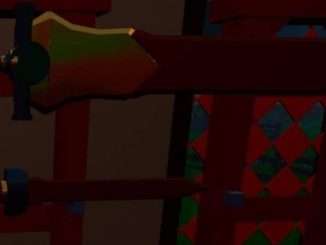
- #HOW TO MAKE A SHIELD IN MY LITTLE BLACKSMITH SHOP SERIES#
- #HOW TO MAKE A SHIELD IN MY LITTLE BLACKSMITH SHOP CRACK#
The five basic forging processes are often combined to produce and refine the shapes necessary for finished products. It also includes cutting, slitting, and drifting-all done with a chisel. Punching is not limited to depressions and holes. For example, in preparation for making a hammerhead, a smith would punch a hole in a heavy bar or rod for the hammer handle. Punching may be done to create a decorative pattern, or to make a hole. An alternative to hammering on the hot end is to place the hot end on the anvil and hammer on the cold end. One form is to heat the end of a rod and then hammer on it as one would drive a nail: the rod gets shorter, and the hot part widens. Upsetting is the process of making metal thicker in one dimension through shortening in the other. Even such common smithing processes as decoratively twisting a bar are impossible with it.

Though rarely hand-worked, titanium is notably hot short. This is a problem for some blade-making steels, which must be worked carefully to avoid developing hidden cracks that would cause failure in the future.
#HOW TO MAKE A SHIELD IN MY LITTLE BLACKSMITH SHOP CRACK#
They become like Plasticine: although they may still be manipulated by squeezing, an attempt to stretch them, even by bending or twisting, is likely to have them crack and break apart. Some metals are "hot short", meaning they lose their tensile strength when heated. Bends can be dressed and tightened, or widened, by hammering them over the appropriately shaped part of the anvil. Heating iron to a "forging heat" allows bending as if it were a soft, ductile metal, like copper or silver.īending can be done with the hammer over the horn or edge of the anvil or by inserting a bending fork into the hardy hole (the square hole in the top of the anvil), placing the work piece between the tines of the fork, and bending the material to the desired angle. This forces the metal to grow in length (and width if left unchecked) much faster than just hammering with the flat face of the hammer. Then the smith turns the hammer over to use the flat face to hammer the tops of the ridges down level with the bottoms of the indentations. The resulting effect looks somewhat like waves along the top of the piece.
#HOW TO MAKE A SHIELD IN MY LITTLE BLACKSMITH SHOP SERIES#
(The technique is called fullering from the tool.) Fullering consists of hammering a series of indentations with corresponding ridges, perpendicular to the long section of the piece being drawn. Two typical methods using only hammer and anvil would be hammering on the anvil horn, and hammering on the anvil face using the cross peen of a hammer.Īnother method for drawing is to use a tool called a fuller, or the peen of the hammer, to hasten the drawing out of a thick piece of metal. If tapered in two dimensions, a point results.ĭrawing can be accomplished with a variety of tools and methods. A taper can result as in making a wedge or a woodworking chisel blade. As the depth is reduced, or the width narrowed, the piece is lengthened or "drawn out."Īs an example of drawing, a smith making a chisel might flatten a square bar of steel, lengthening the metal, reducing its depth but keeping its width consistent.ĭrawing does not have to be uniform. Traditional blacksmith next to his forge of stone and brickĭrawing lengthens the metal by reducing one or both of the other two dimensions. The techniques of smithing can be roughly divided into forging (sometimes called "sculpting"), welding, heat-treating, and finishing.

The key is to have consistent lighting, but not too bright.


Because they must be able to see the glowing color of the metal, some blacksmiths work in dim, low-light conditions, but most work in well-lit conditions. The ideal heat for most forging is the bright yellow-orange color that indicates forging heat. As iron heats to higher temperatures, it first glows red, then orange, yellow, and finally white. Induction heating methods are gaining popularity among modern blacksmiths.Ĭolor is important for indicating the temperature and workability of the metal. Some modern blacksmiths may also employ an oxyacetylene or similar blowtorch for more localized heating. Heating generally takes place in a forge fueled by propane, natural gas, coal, charcoal, coke, or oil. Smithing process in Mediterranean environment, Valencian Museum of Ethnologyīlacksmiths work by heating pieces of wrought iron or steel until the metal becomes soft enough for shaping with hand tools, such as a hammer, an anvil and a chisel.


 0 kommentar(er)
0 kommentar(er)
